Last updated on June 24th, 2025 at 12:36 pm
The most important thing you need for good flavoring is best oil for Cast Iron Seasoning. For flavoring purposes, you need oil with a low smoke point, which can rapidly oxidize and carbonate on heat. This is due to the burning oil that forms a non-stick coating on the surface of cast iron cooking equipment. And then you will find best oil for Cast Iron Seasoning.
However, low smoke oils are best comparing to high smoke points such as peanut, sunflower, saffron, or soybean oil when it comes to excellent and proper flavoring.
If you want to use nut or vegetable oils, they must refine. The simple answer can remain on smoke at high temperatures is to use the best oil for processing cast iron cooking tools.
What is Cast Iron Seasoning?
Cast iron is a solid and light metal, especially a weird blend for a cooking process. The metal is physically stable but highly reactive; meaning even a drop of water sitting on your cast iron pot can leave a rusty spot. To protect that nice black surface, you need to coat it with a thin layer of hardened oil called seasoning.
To get a well-processed pan, you pour oil inside the cooking surface and then heat it until the fat polymerizes, repeating the process of creating a protective layer.
Polymerized oil is more like plastic than fat, which makes it harder and more resistant to sticking. By heating the whole pan to a high temperature, you connect the oil permanently to the raw iron. In this form, it protects the metal from wind and food.
Modern pans, unlike vintage items, always pre-processed. This is a great feature. Most people do not have modern pans. It does mean you do not need to learn how to season cast iron. So when the surface decays, they don’t know how to re-season.
Fortunately, the process is very easy. Once you season it again, the pan will be almost brand new. But you have to follow a few steps first.
Related Post: What Does Hummus Taste Like?
How to Season Cast Iron Skillet:
- To remove rust stains, rub on this simple rust eraser stain, and then roast again.
- Find it at hardware stores, bike stores, or woodworking stores.
- To clean, use a stiff brush or plastic scrubber under running water when the cast iron is still hot but cool enough for easy handling.
- Kosher salt is the right scrubbing agent for baked stains. The most important tip is never to use soap!
- Never marinate on cast iron. Acidic compounds can damage the flavor.
- If food particles start to stick, rust will appear, and you experience a metallic taste.
- Before cooking, apply vegetable oil on the cooking surface, heat the pan over low heat, and slowly increase the temperature.
- Spread a thin layer of melted wrinkles or vegetable oil on top of the pan.
“Below are our 10 recommendations to help you determine the right oil for flavoring”
1) Avocado Oil
- For Food and Beyond: Handcrafted from premium avocados, this emerald green oil is wonderful in salad dressings, on fresh cut fruit or grilled fish. It’s also great for skin and hair
- Quality You can Taste: The mainstay of all La Tourangelle’s artisanal oils is premium taste derived from the best quality ingredients. Add the flavor of La Tourangelle to any meal
- Delicious and Versatile: Our oils, dressings and vinaigrettes make it easy to create distinctive dishes for professional chefs, novice cooks, and foodies. Great for salads, meats, pastas and more
- Sustainable: La Tourangelle’s artisan oils and vinaigrettes provide the perfect touch to make a gourmet breakfast, lunch, or dinner. We strive to make carefully crafted, sustainable products. Expeller-pressed, Non-GMO, and Kosher
- Flavors of the World: From Organic Extra Virgin Olive Oil and sustainably produced Grapeseed Oil, to award winning Toasted Sesame Oil, La Tourangelle brings the best oils and flavors from around the world straight to your kitchen.
As an Amazon Associate I earn from qualifying purchases.
Avocado oil is also appreciated for its health benefits. Although it is more expensive than some of the other options on this list, it is neutral-flavored oil.
Avocado oil has high smoke point at 520F temperature. The downside is that to use this for your pan seasoning; you need to heat the pan to a temperature of 520 F before adding the oil. In any case, handling a pan with this heat is dangerous. Placing the oil in a pan will increase the risk level.
Suppose you can taste a pot with avocado oil. In that case, you won’t cook anything at a temperature high enough to break the established bond. However, the risks involved are enough to prevent many average cast iron pan owners from trying this option.
2) Coconut oil
- Prevents Rusting: Formulated to help protect your cookware from moisture and rust. This vegan cast iron seasoning oil is an excellent alternative to mineral oil, ensuring long-lasting seasoning for your cast iron care routine.
- Cast Iron Conditioner for a Smooth Finish: Helps enhance the natural non-stick surface of your cookware. CLARK’S cast iron conditioner and griddle oil improve the griddle seasoning process, delivering a smooth finish for all your cookware.
- Premium Food-Grade Coconut Oil: CLARK’S uses refined coconut oil, a plant-based, food-grade oil, to help maintain the cast iron seasoning on cast iron skillets, griddles, Dutch ovens, and more.
- Resists Going Rancid: Made from fractionated coconut oil, our product is formulated to resist rancidity, making it a reliable choice for regular maintenance and cast iron cleaning.
- No Oven Required for Cast Iron Care: Simply apply CLARK’S cast iron oil seasoning after each use—no need for oven seasoning. Save time and effort while maintaining the seasoning and care of your cookware.
As an Amazon Associate I earn from qualifying purchases.
If you like coconut, the aroma, and mild taste are heavenly. If you don’t like coconuts, you won’t have a gallon sitting in your closet. But the question is: Can coconut oil be used for season cast iron?
Clark’s Coconut oil is tried after for cast iron flavoring options. It has become top-rated oil over the last decade, thanks to its health benefits, and now you can buy it at very reasonable prices.
Yes, you can use coconut oil to flavor and cast iron seasoning. Still, it has a relatively low smoke point, so you need to be careful about flavoring first.
Add the coconut oil and make sure your pan is warm to about 350F before wiping it well. The temperature should fill the smoke point of your choice’s oil, but not higher than that.
If well processed, the pan will be fine. If the spice is not taking, whenever you cook food at a temperature higher than the smoking point of coconut oil, it will begin to break down the carbonated fat. Coconut oil is the right solution for cast iron flavoring if you do not often cook at high temperatures.
3) Yandilla Grade All Natural Mustard Oil

Blends of soybean oil, beeswax, and palm oil should not go fragile. It smelled like honey during the flavoring process. The disadvantage is that the fried chicken took up quite a bit of its flavor and the pan was dull after cooking with the tomatoes.
The mustard oil is tough to move around the corner of the pan. With a still-hot pan, Things melt a little soon as the oil hits the pan.
A piece of cloth had to be used to wipe the thin coating. It works much better as a kind of thing that you can use for your new toolkit.
As an Amazon Associate I earn from qualifying purchases.
4) FlaxSeed Oil
Flaxseed oil flavoring cast iron was very popular when a top blogger wrote about it a few years ago. This oil has a very low smoke point.
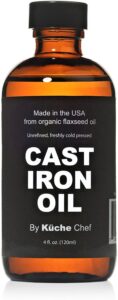
- Kuche Chef Cast Iron Oil is made from flaxseed oil that is grown and pressed pure in the USA – North Dakota. It is 100% organic flaxseed oil that contains a high concentration of Omega-3 fatty acids
- We will teach you how to season and prolong the lifespan of your cast iron cookware
- Unlike canola oil, palm oil, or other types of common household oils, flaxseed oil is a drying oil. The oil will never go rancid or make your cast iron sticky. This organic essential oil formula helps keep your cookware smooth, shiny, and non-stick result
- Kuche Chef designed this cast iron oil to help restore, build and maintain a natural seasoning on your cookware. Making your kitchenware easier to clean and pleasant to cook with, your food will taste better!
- Flaxseed oil is the only drying oil that’s edible, this makes our organic cast iron oil perfect for creating a non-stick seasoning on your cast iron via fat polymerization
As an Amazon Associate I earn from qualifying purchases.
To pay for not processing it at high temperatures, it is advisable to season at least 6 times for 1 hour at a low temperature of 225F. It works well, but after several third-party tests; it is not as radical as first suggested.
Flaxseed oil binds well to the iron, giving it a smooth finish that makes you feel slip without sticking. If you use your equipment regularly, flaxseed oil is a great choice for cast iron flavoring. It dries naturally and is an excellent perk for iron casting, which is very sensitive to any moisture.
The taste is undetectable when used for flavoring. Still, since it is seed oil, it is ideal for pots that receive regular use. If you use your cast iron only once a year, the oil can leave a shelf on the shelf that smells like an oil painting.
If this happens and you want to use it, rewash your pan well and season.
5) Canola Oil or Vegetable Oil

As an Amazon Associate I earn from qualifying purchases.
You can use Canola Oil or Vegetable Oil for cooking or seasoning. No smell, no pressures. The spray-on form seems to facilitate the application of a thin coat, but it is not so in practice. The oil comes out in a thick droplet or a large cloud. It still needs to remove excess.
Canola oil in a DIY spray bottle works well. It worked well enough in terms of performance, but it wasn’t the best. Foods cooked in the pan were more likely to stick and lost a magnet after the first test run of flavoring.
6) Pompeian Extra Virgin Olive Oil
- Farmer-crafted
- Robust flavor
- Imported, first cold pressed extra virgin olive oil
- Perfect for pasta, marinades and salad dressings
- Quality since 1906 from the Olive Oil People
As an Amazon Associate I earn from qualifying purchases.
Olive oil has a wonderful taste, a beautiful aroma, and many health benefits. Most people have olive oil in their kitchen cabinets, which is easy to find in any supermarket and is not overpriced.
These are all benefits of using olive oil for cast iron seasoning.
It has a lower smoke point. If you choose extra virgin olive oil for your cast iron pan seasoning, do so at low temperatures at long intervals.
To make sure you don’t overheat your olive oil, using an oven is a great way to set the temperature. Hence, it stays hot, so the pan will accept the seasoning but not hot enough to burn your oil. 375F is suitable.
Suppose you are not very careful in the initial flavoring of your pan. In that case, the oil will not bind to the cast iron. When cooked at a temperature higher than the smoke point of 375F olive oil at any time, it will begin to dissolve and shatter, which is not desirable.
7) CLARK’S Cast Iron Seasoning Peanut Oil
- COMPLETE CAST IRON CLEANING KIT –This comprehensive cast iron cleaning kit includes CLARK’ S food-safe cast iron seasoning Oil (12 oz), Cast Iron Soap (12 oz), CLARK’s Round Scrub Brush, and CLARK’s Round Applicator Pad, essential for all your cast iron accessories and bakeware
- PREMIUM CAST IRON CLEANER OIL –Specially formulated for your cast iron or carbon steel pots, pans, skillets, woks, griddles, and dutch ovens, we use only the most refined Food-Grade Coconut Oil ensuring the best possible seasoning, making it the perfect cast iron cleaner conditioner
- ORGANIC CASTILE BASED COCONUT SOAP –Our all-natural cast iron soap and oil, indispensable cast iron care products, contain NO Parabens, Phosphates, or synthetic foaming agents, making it the ideal cast iron pan cleaner
- LONG-LASTING AND DOES NOT GO RANCID –Unlike grapeseed, flaxseed, canola or palm oil, this cast iron oil and soap, the cornerstone of any cast iron cleaning kit, will never go rancid and does not need to be refrigerated, perfect for your cast iron griddle and grill pan
- EXPERT SUPPORT –We stand behind our cast iron kit and are committed to your satisfaction. We respond to every customer email to ensure your experience matches the quality of our cast iron oil cleaner and other products
As an Amazon Associate I earn from qualifying purchases.
By almost all means, peanut oil is medium-sized oil for flavoring cast iron. It’s not overpriced or hard to find, but it’s not too cheap.
The most significant risk of using peanut oil during your cast iron season is that you should always be careful when using it for cooking food for someone with a peanut allergy.
Even if it sinks into the pan’s holes, it can change into the food you are cooking and cause an allergic reaction.
You will want to double-check whether your oil is refined or unrefined, as they have different smoke points. So they must be processed at different temperatures.
It has a high smoke point from the middle at 450F for refined oils, and it is most commonly using in deep frying and cooking, so you may already have some.
8) Grapeseed Oil
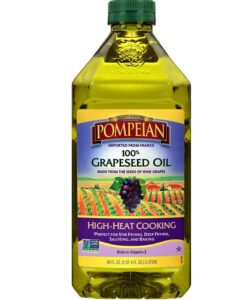
- GRAPESEED OIL: Pompeian imports 100% of its Grapeseed Oil from France.
- LIGHT AND SUBTLE FLAVOR: Pompeian’s 100% Grapeseed Oil is a light, all-natural cooking oil with a high smoke point, perfect for stir-frying, deep frying and baking!
- PERFECT FOR HIGH HEAT – With a smoke point of up to 510 degrees, our Grapeseed Oil is the perfect companion for all your recipes, whether you’re cooking, baking, frying or air frying!
- FARMER CRAFTED: Quality from The Olive Oil People Since 1906.
- COMMITTED TO QUALITY: Pompeian 100% Grapeseed Oil is Naturally Gluten Free and Non-Allergenic, Kosher, and Non-GMO Verified by the Non-GMO Project.
As an Amazon Associate I earn from qualifying purchases.
It is one of the most popular oils using by expert chefs and cast iron professionally. It has a high smoke point, which allows the pan to heat up quickly using high temperatures and form a bond between the oil and the pan.
Grapeseed Oil is entirely neutral in aroma and taste, making it perfect for seasoning your pan. So, every meal you cook will then start fresh.
It is also highly regarded as a healthy choice for oil. It is moderately priced, which attracts many reasons.
9) Crisbee Stik Cast Iron Oil
- Made with Non-GMO Soybean Oil, Beeswax, and Non-GMO Palm Oil. A little goes a long way. Very economical compared to seasoning cast iron cookware with oil.
As an Amazon Associate I earn from qualifying purchases.
Cast iron seasoning with butter is a simple, tasty way to season your pan with regular use, but you want to make sure you are using real unsalted butter.
Margarine or butter substitutes are not good options for cast iron flavoring. You always want to avoid using anything salty to season your dish. However, it can cook with salt.
Using butter as a first seasoning may not even give you a black appetite like some of the oils on this list, but it will develop nicely over time. Crisbee Stik is a best option, but if you have butter and use it a lot in your cooking, it will work.
Ghee is very similar to butter, with one big exception: it has a very high smoke point. The butter hits the high end of the optimum cooking temperature at 300F. The ghee will retain heat up to 475F. However, it still doesn’t even offer a season. Depending on your preferences, you may rate them differently.
10) Cast Iron Seasoning & Cleaning Oil

- PREMIUM CAST IRON CONDITIONING & SEASONING OIL | Made with FOOD grade, solvent-less, refined coconut oil that is safe for food contact and cast iron surfaces. The result is a premium product that unlike our competitors is guaranteed to be made exclusively from coconuts that does not go rancid.
- SEASONS CAST IRON | Designed to season & condition cast iron while protecting cookware from moisture that leads to damage & rust. Makes cleaning cast iron easier by creating a seasoning that is non-stick & prevents food from drying on.
- CLEANS & ELIMINATES ODORS | Enhanced with a proprietary blend of pure essential oils that help to naturally eliminate food odours. Will leave your cast iron skillet or cookware looking & smelling clean, yet neutral. Very light scent that will not transfer onto food
- DOES NOT GO RANCID | Unlike canola oil, hemp, flax seed or other types of common cooking oils, this cast iron oil will never go rancid. It is made with a solvent-less, refined coconut oil base that has had it’s long-chain fatty acids removed.
- BACKED BY THE CARON FAMILY GUARANTEE | Our family takes great pride in the products we create & are confident you & your family will enjoy them as much as we do. If for any reason you are not 100% satisfied, we’ll refund your money!
As an Amazon Associate I earn from qualifying purchases.
Historically, cast iron has been the most readily available fat source to prevent rust and maintain a clean sheet.
As long as you have no dietary or ethical personal reasons for using animal fat, it still works best. Use Caron & Doucet to process your cast iron by working it into a slightly melted iron in your hot pan.
If your pan is not using regularly, the animal fat shown will not work well. Putting your pan is upside down or covered with a lid, it will still be more likely to create a bad odor that can transfer to your food. If you use lard for cast iron seasoning, be sure to use your pan frequently and store it somewhere with adequate ventilation.
Hopefully, this article has helped you determine your priorities for choosing the right oil to process your cast iron, and the chart is a useful quick reference tool for you. Related Article: Does Balsamic Vinegar Go Bad?

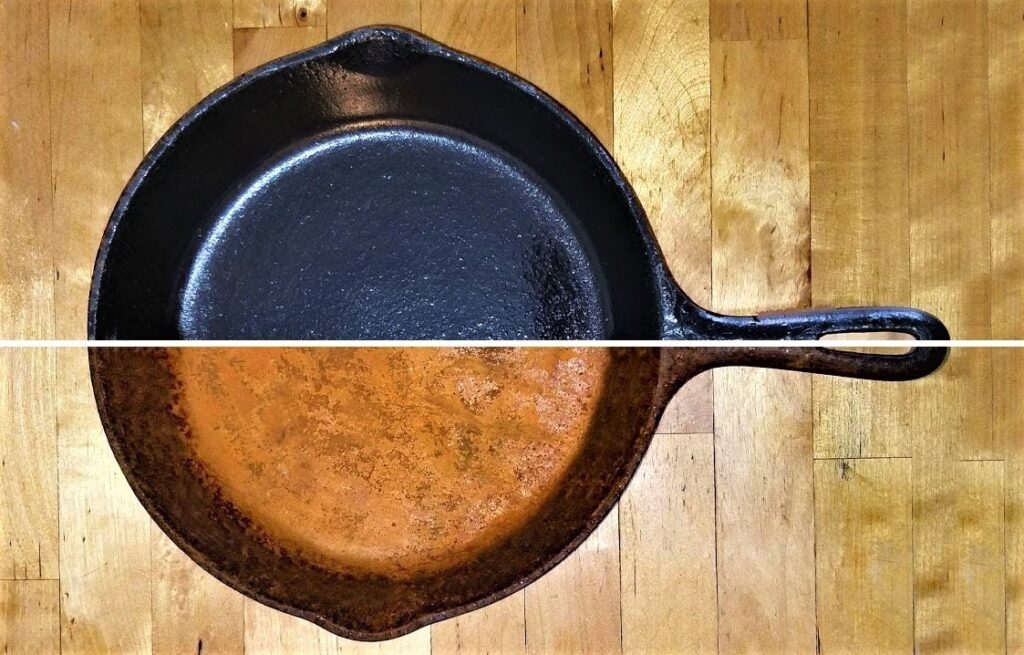

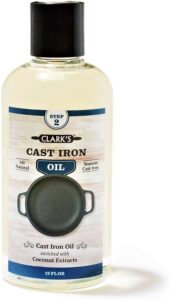
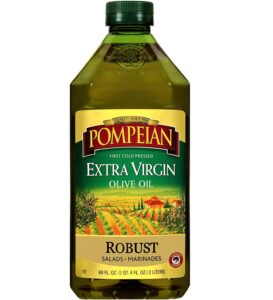


Comments are closed.